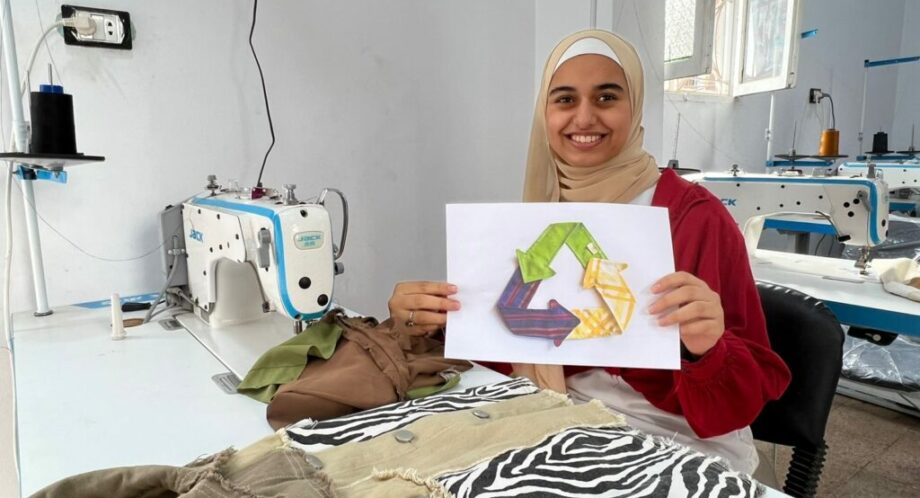March 7, 2024 —  Editor’s note: This story is part of a collaboration between Ensia and Egab exploring environmental efforts by communities facing potentially more urgent concerns such as war and poverty. Egab is a media startup that helps young local journalists from across the Middle East and Africa get published in regional and international media outlets, with a focus on solutions journalism. You can read the other stories in the series here and here.
Editor’s note: This story is part of a collaboration between Ensia and Egab exploring environmental efforts by communities facing potentially more urgent concerns such as war and poverty. Egab is a media startup that helps young local journalists from across the Middle East and Africa get published in regional and international media outlets, with a focus on solutions journalism. You can read the other stories in the series here and here.
To the sweeping majority of roughly 4.7 million people living in Monofeya, one of Egypt’s poorest provinces, “sustainable fashion” is a term that likely means very little. But it’s here, where 26% of the population lives below the poverty line, that a single business upcycled around 940 tons (850 metric tons) of fabric in five years.
“We, as entrepreneurs, were interested in creative manufacturing and environmental solutions after noticing the amount of textile waste,” says Amgad Moustafa, co-founder of Green Fashion, the brand that has brought together some 200 women to breathe new life into piles of fabrics and textiles that would otherwise get incinerated or dumped in landfills. The business, which began in 2018, uses surplus fabrics and textile waste from 50 textile factories for its raw materials.
Each year, Egypt’s sprawling garment industry — which accounts for 4% of the country’s GDP — produces around 234,000 tons (212,000 metric tons) of textile waste, according to a UN study.
And the environmental impact of the global fashion industry is massive.
It takes 10,000 liters (2,600 gallons) of water to grow the cotton for a single pair of jeans, enough to hydrate one person for 10 years, according to the UN. And according to recent reports by McKinsey, the industry produces 3–10% of total greenhouse gasses, its solvents and dyes make up a quarter of industrial water pollution, and in recent years it has accounted for 20–35% of microplastic flows into the ocean. The UN has called fast fashion “an environmental emergency.”
Things changed with the advent of mass production and fast fashion. But today, as the economy struggles, repurposing and reusing again are on the rise.
In recent years, an ailing economy in Egypt, the Arab world’s most populous country, drove consumers to search for cheaper alternatives to internationally branded ready-made clothes. This spurred an appetite for recycled and upcycled garments, which in turn is reducing fabric waste, creating job opportunities, and unleashing creativity as individuals and entities find ways to repurpose fabrics and used clothing.
Silver Lining
According to sustainable fashion advocates, reusing or repurposing clothes is not new to Egyptians. “Sustainability as an idea existed in all Egyptian social levels,” says Esraa Aburehab, a sustainability and environmental development consultant. “I mean, who didn’t wear their older relatives’ clothes, while other specific pieces were circulated among family members?”
Things changed with the advent of mass production and fast fashion. But today, as the economy struggles, repurposing and reusing again are on the rise.
Waves of currency depreciations since 2016, compounded by economic disruptions due to the war in Ukraine, have led Egypt’s inflation rates to skyrocket. In June 2023 rates hit a record high of 36.8%. In April of that same year, the Egyptian pound was ranked among the worst performing currencies in the world.
The impact of this economic downturn has rippled across all classes. Millions have been pushed into poverty, and clothing is among many goods and services that has been impacted.
“We used to travel to Cairo several times a year just to visit the malls and buy new clothes,” says Rahma Youssef, a teacher from the coastal city of Suez, 140 kilometers (87 miles) northeast of the capital. “Then, the prices soared. What used to get us two or three pieces now barely covers one item,” she adds, explaining that she and her sister now rely on thrifting, buying custom-made clothing (which is often cheaper than name brand items), and repairing and restyling old clothes.
According to Basma Tawakol, founder of the online thrifting store Dayra, the need for cheaper clothing opened the door for sustainable fashion. “With the devaluations, people searched for alternatives to the deliberate price hikes,” Tawakol says. “I thought my customers would be from the middle and lower classes, but I also got some returning upper-class customers.”
Since its launch in 2020, Dayra has been releasing an upcycled collection of about 12 pieces every few months, by mixing and matching the different fabrics and old garments.
Meanwhile, Green Fashion mass produces upcycled garments, relying on defective rolls of fabrics that cost no more than 25% of the intact ones, as well as unwanted second-hand clothes to produce their pieces. “We once produced a thousand pieces from fabric waste and defective bolts,” says Moustafa. “We usually produce one new piece out of every four preowned clothes.”
Acquiring Skills and Knowledge
Green Fashion not only upcycles fabrics, it also builds skills. The business trains new tailors for six months — two months on sewing and another two months on recycling. After completing training, tailors work under supervision before being allowed to work on their own, Moustafa explains.
Green Fashion hires only women. As a result, it “helps the local community, achieving a social impact alongside its environmental goals, by empowering women who otherwise had no or little income, training them, and offering them a decent job,” Moustafa says.
“We’ll spread the concept of sustainability, one person at a time.” —Amgad Moustafa
Sohair Asfour, a mother of four, was a full-time homemaker until 2018, when her husband lost his job, leaving the family in need of income.
“At Green Fashion, I learned embroidery and sewing, and currently I’m helping our trainers teach the newcomers,” says Asfour. “My work helped me lead a better life and changed my mindset toward old items.”
Youssre Abdelkader, co-founder of From Waste to Good Taste, a sustainable design initiative, says their workshops, which began in 2021 to teach repair and upcycling methods, such as patchwork, draw students of different ages. “At first, most of our workshop attendees were students and fresh graduates. By time, the age group started to expand, and people in their 40s and 50s are joining in now,” she says.
Green Fashion recently began training in two other impoverished Egyptian governorates, Gharbia and Aswan. “We aim to hire another 300 women in these new production units, and to upcycle 1,000 metric tons (1,100 tons) of waste by the end of 2024,” Moustafa says. Additionally, Green Fashion plans to launch a fabric donation vehicle in Egypt’s rural areas and universities.
“We’ll spread the concept of sustainability, one person at a time,” Moustafa says.
Related Posts
Ensia shares solutions-focused stories free of charge through our online magazine and partner media. That means audiences around the world have ready access to stories that can — and do — help them shape a better future. If you value our work, please show your support today.
Yes, I'll support Ensia!




